Mantrailing Progression Session near Wantage
5 teams were out on Sunday. Two teams had only just completed their introduction workshop the previous week and were keen to get out and try out thier new skills. They were both fab! We had a fun afternoon. Showing the new teams the ropes and testing the other dogs, trails in the woods and in more open ground. All the dogs and handlers worked well. Confidence building and having fun is key! We finished just before it got really dark and the weather was very kind to us.
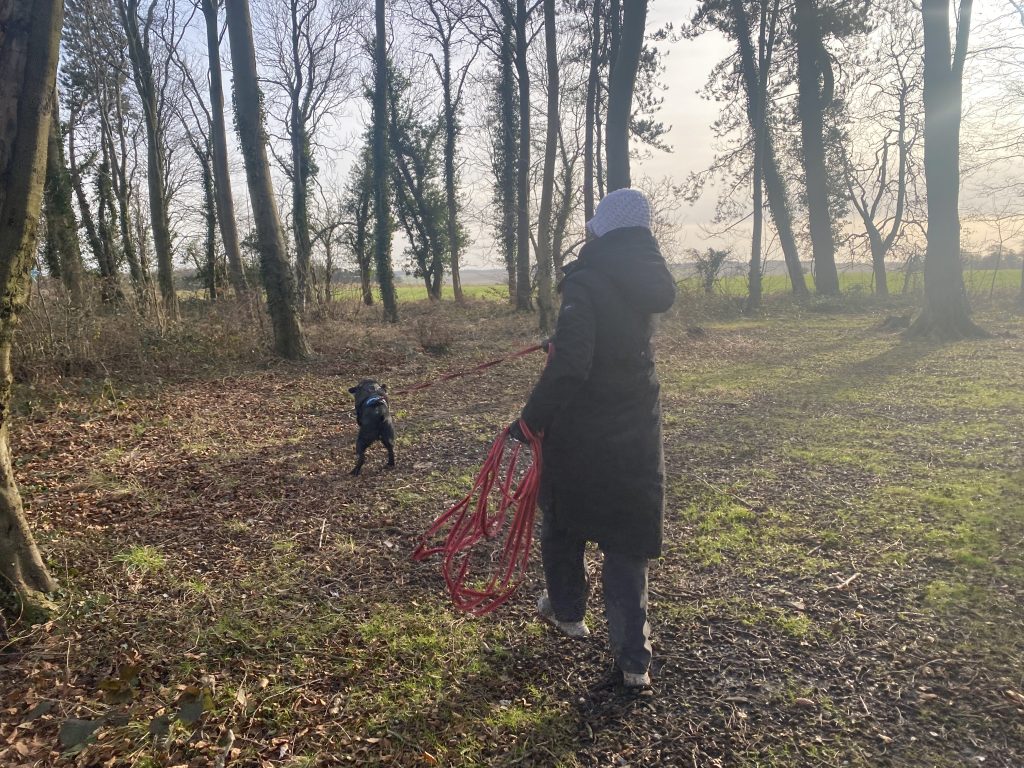
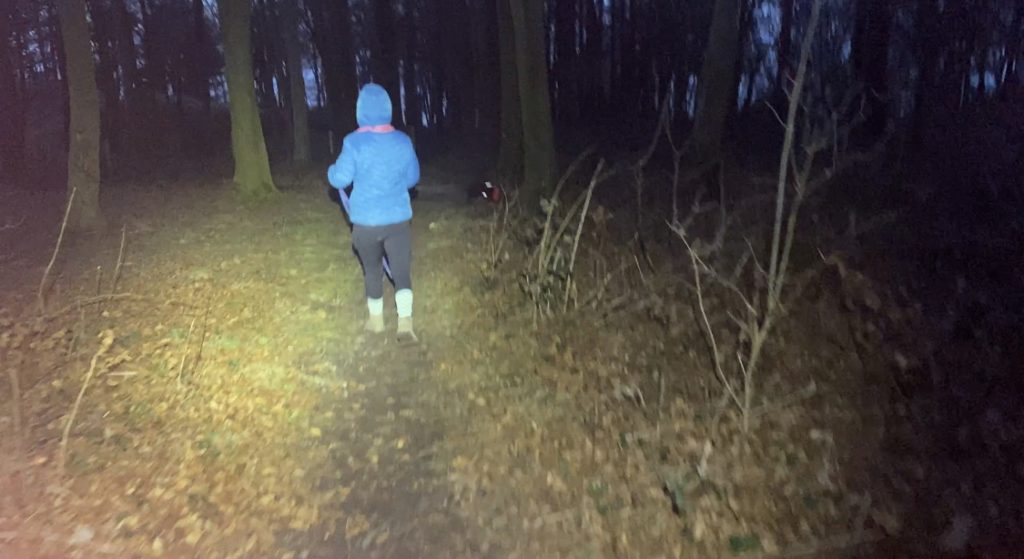
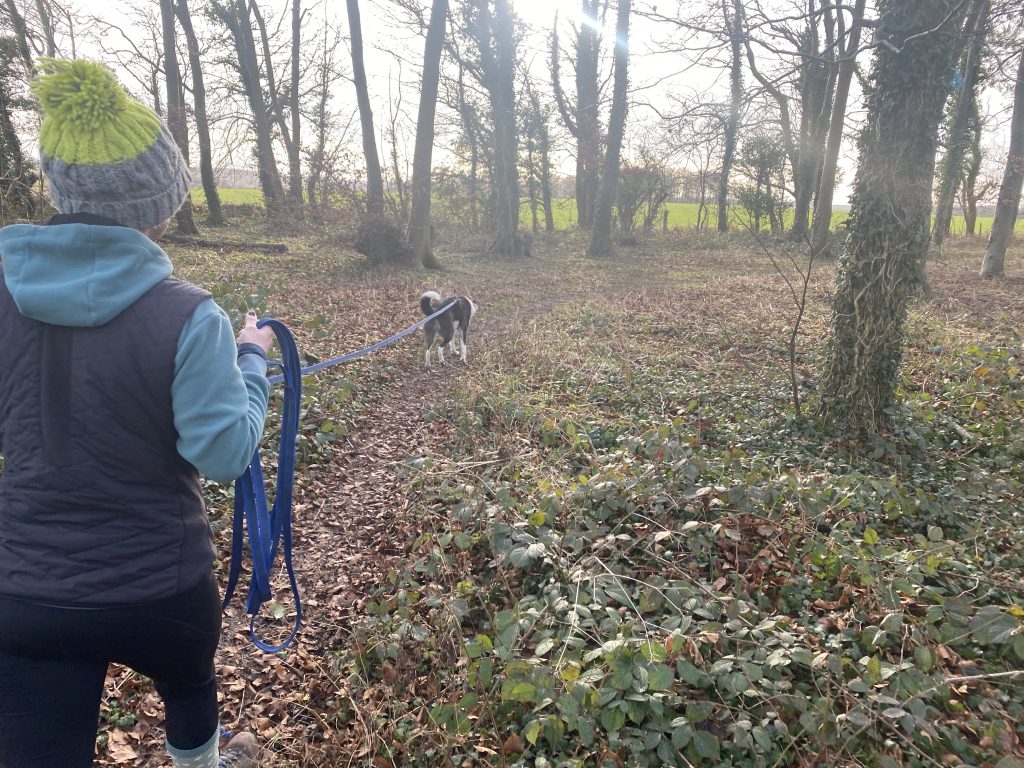
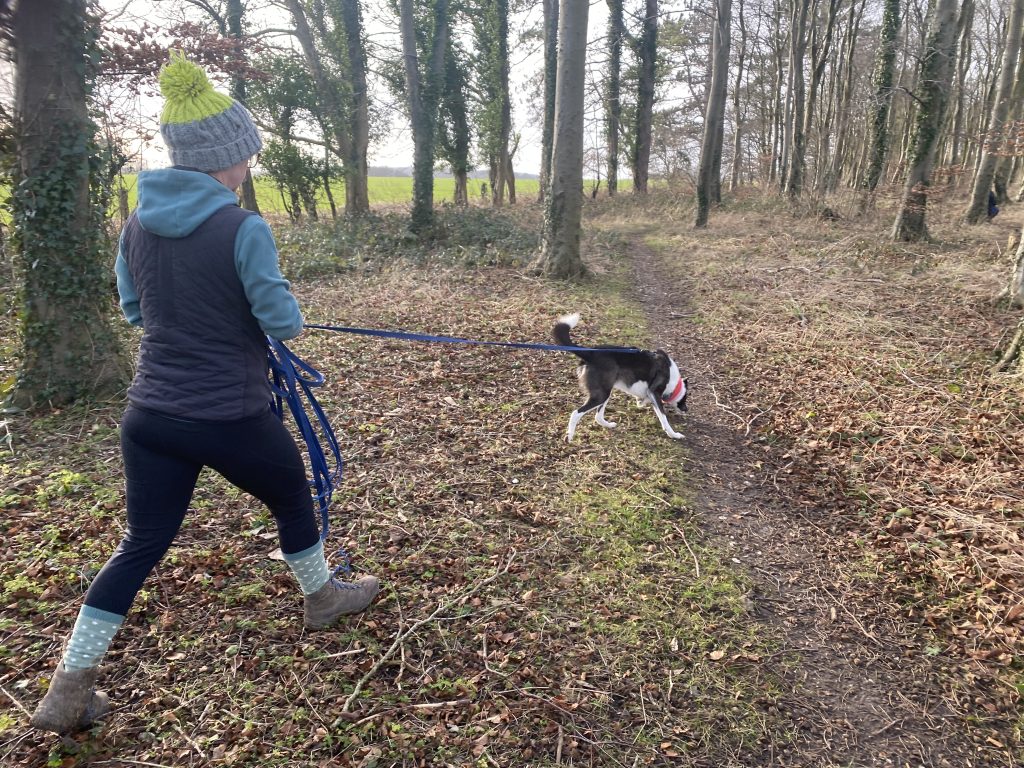
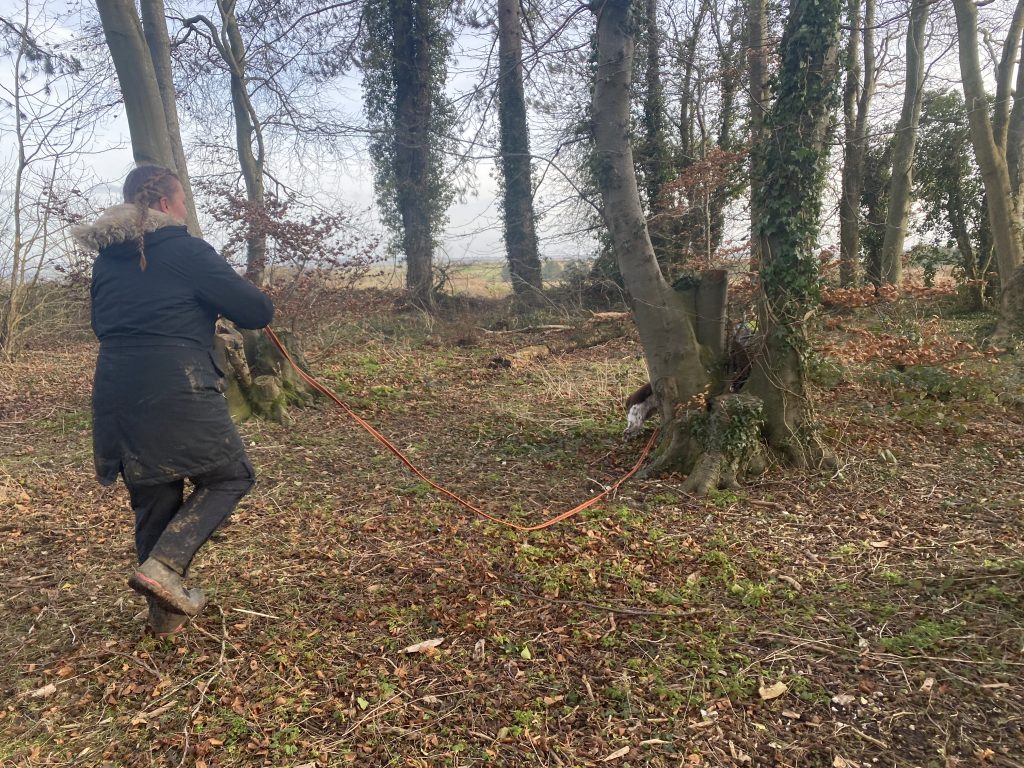
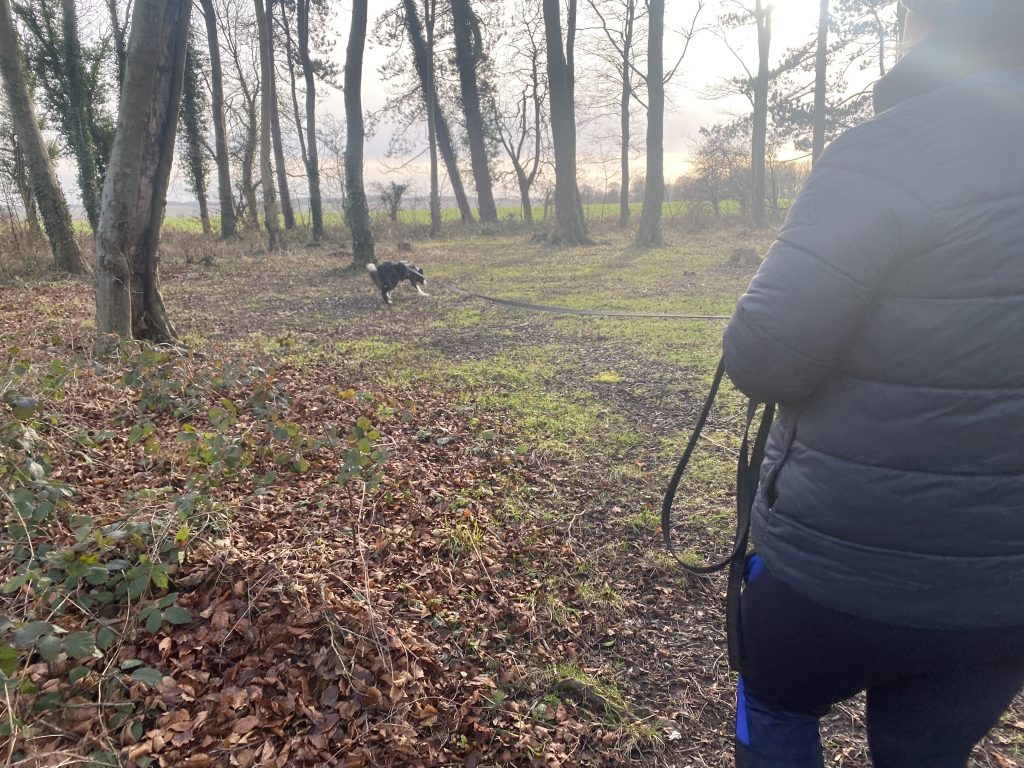
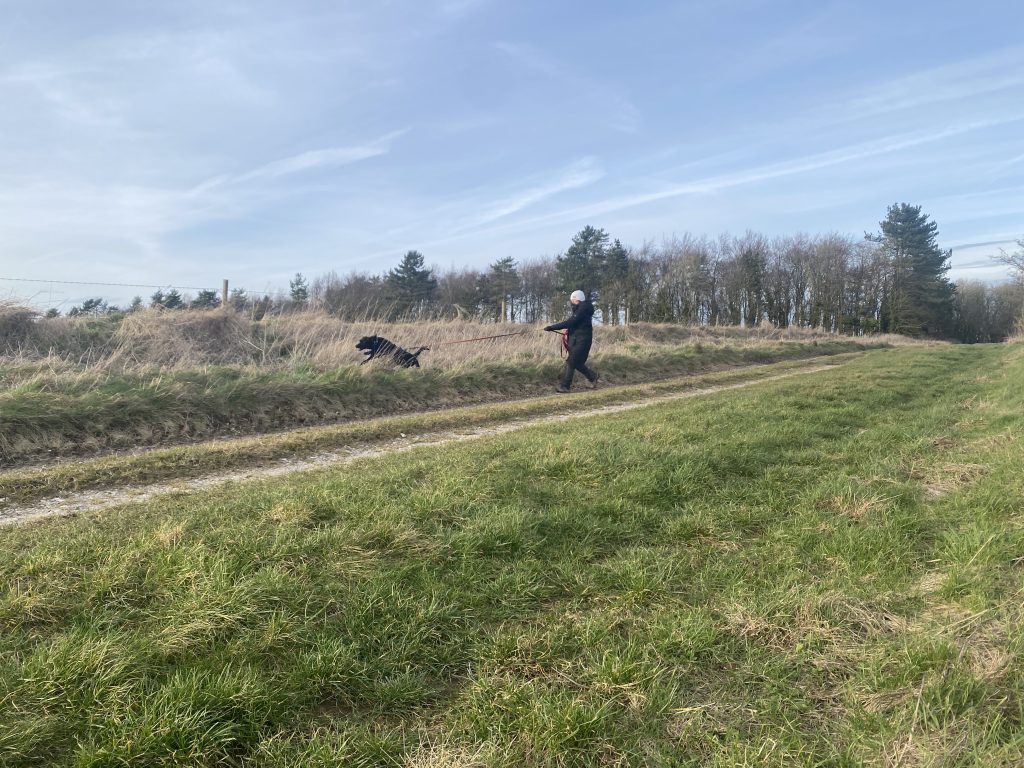
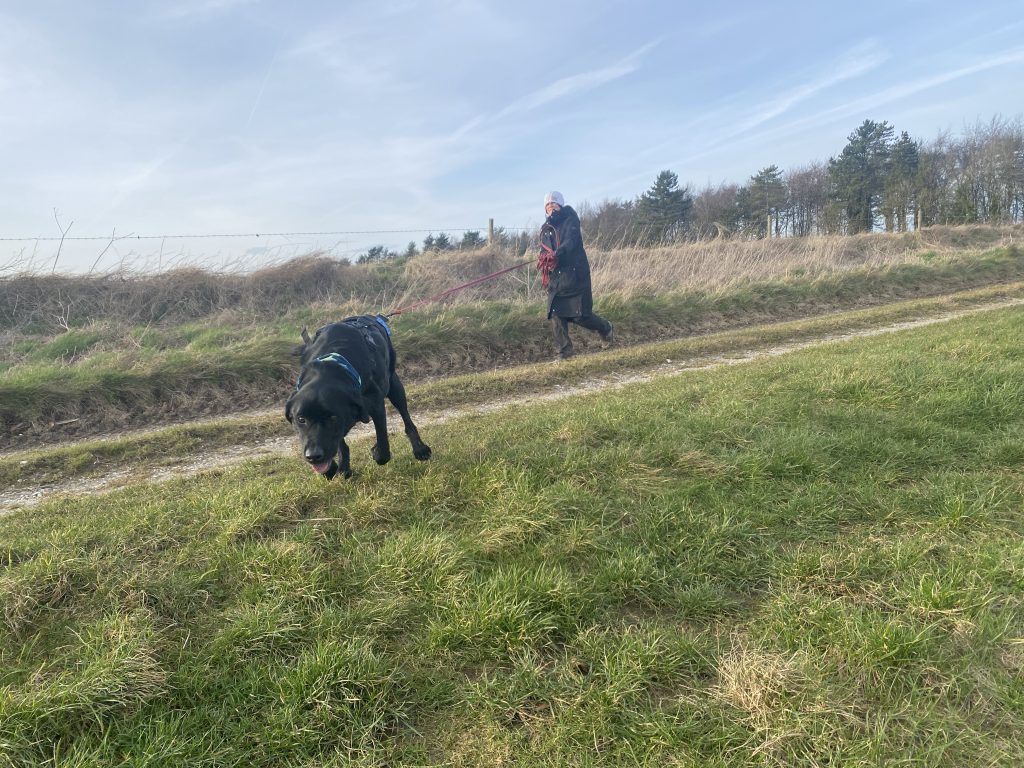

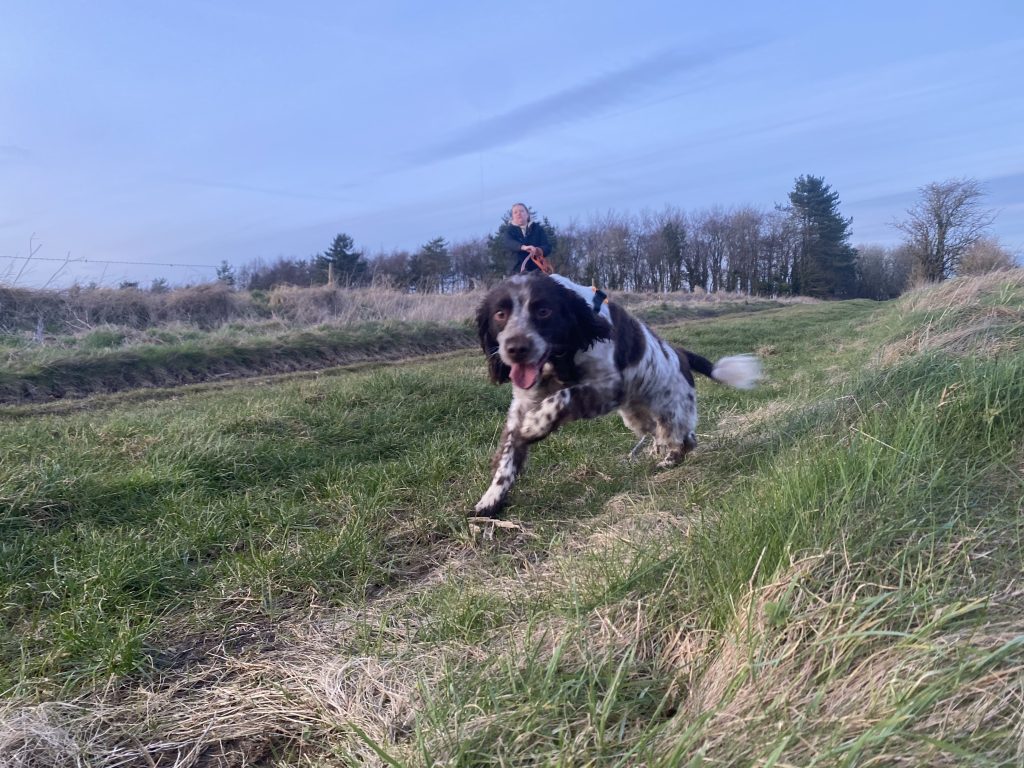
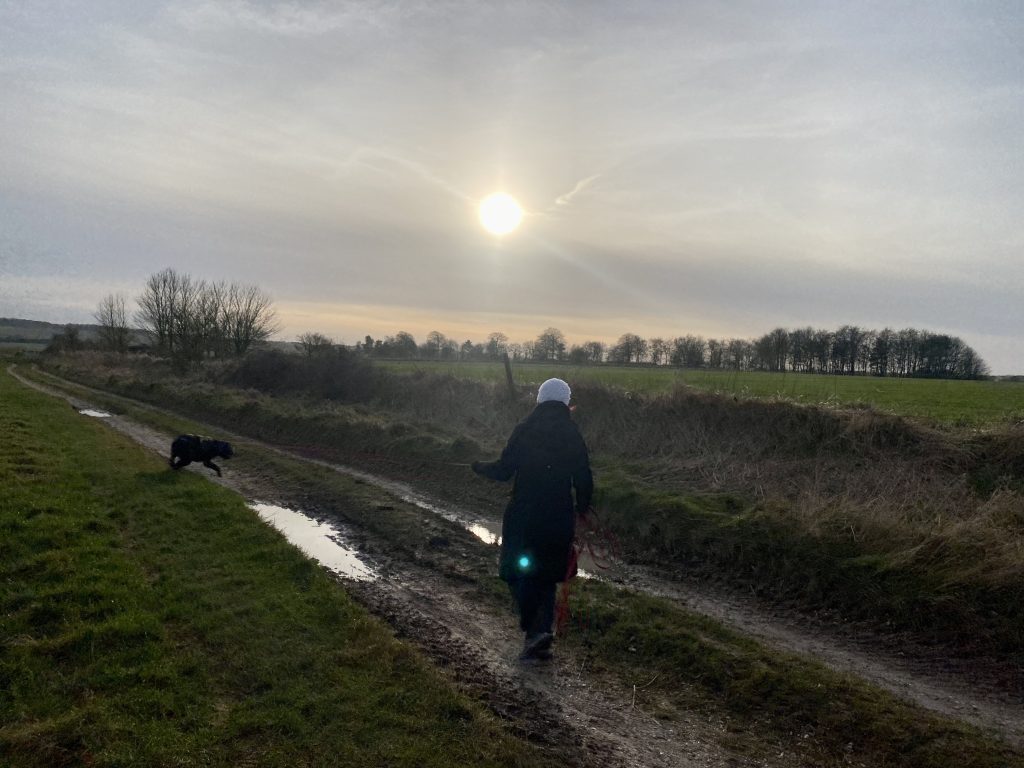
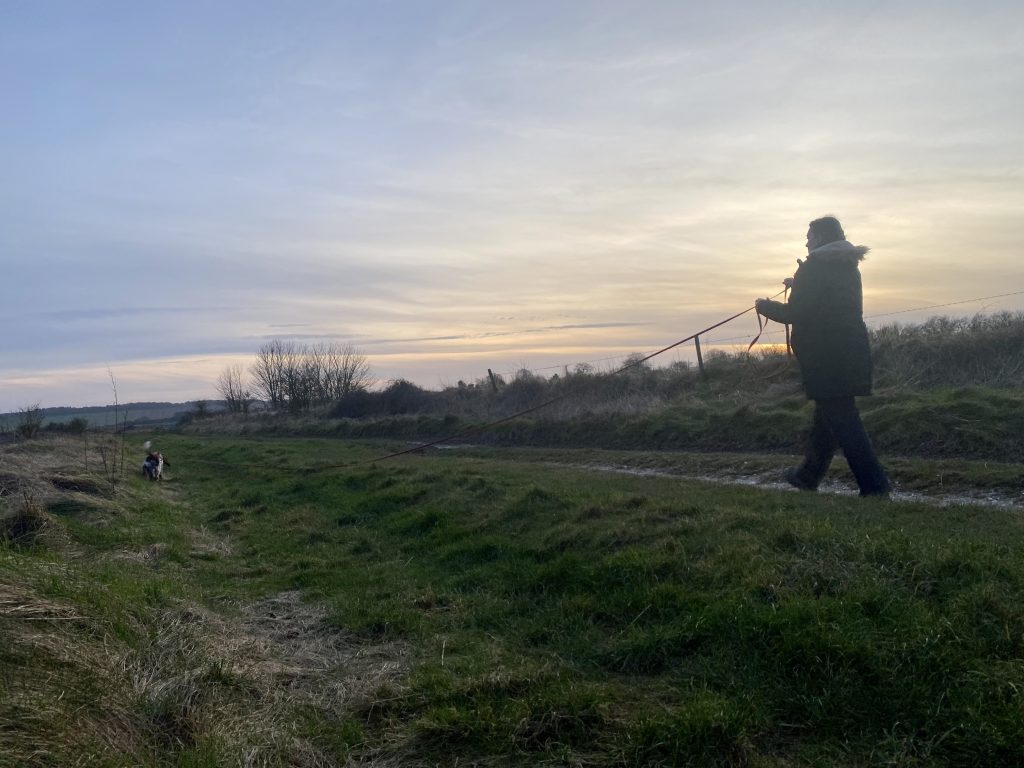
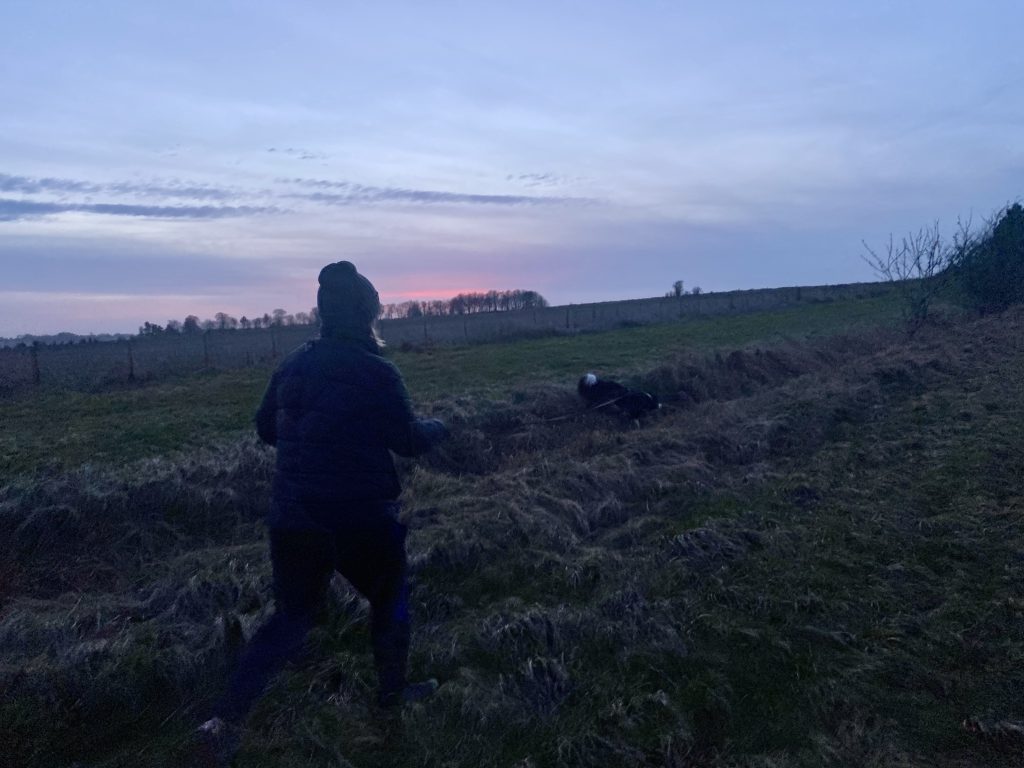
Mantrailing – What is it?

Mantrailing is a fab new dog sport, in fact it is the fastest-growing dog sport in the UK. But don’t let the word sport put you off, it’s all done at a walking pace and the dog is on a long line, so you don’t even have to worry about not having a good recall.
Mantrailing is finding a person for fun! It’s like an Adult and Dog game of Hide & Seek!
Who is it for?
Humans – Anyone can take part, although you do need to have a dog! I have clients in their 20’s all the way to their 80’s
Dogs – Small, large, young and old, I have clients with pups starting at 20 weeks of age and my eldest dog is well into their teens! They do obviously need to come with a human!
So to sum it up. Mantrailing is for anyone with a dog that wants to have fun, build a great relationship with them, meet other people and spend time in the fresh air!
Don’t worry if your dog is nervous or reactive, the dogs are worked individually, and never pushed out of their comfort zone and you will see them become less nervous and less reactive as their noses take over and they do what they love to do…. sniffing!
Your dog does have to wait in the car between turns so if this will be difficult for them, you may need to bring someone to sit with them to start with if you think it will be a problem.
How do I get started?
Firstly you need to find a Mantrailing UK instructor…. well done … you have found me!
However, there is a list of instructors on the Mantrailing UK website (www.mantrailinguk.com) and lots of other great information. Once you have completed your Mantrailing UK Introduction course you can trail with any instructor around the country, so you can even play if going on holiday!
First, you need to book on to a Mantrailing Introduction Workshop. See the link here for my booking options – https://www.meltaylordogtraining.co.uk/book-session
What happens on the Introduction Workshop?
This is all about teaching you and your dog the Game of Mantrialing.
All you need to come is a dog, a harness, a longline (although these can be borrowed and bought on the day), two small pots to put food in, food to put in the pots, something that they will really want. a toy if the dog is very toy motivated and last but not least, an article of clothing, such as a hat, scarf or glove, in a sealed bag or glass jar, that a dog can take your scent from.
Introductions workshops are typically 3 hrs long and comprise of around 3/4 hrs theory and then practice getting to learn the game with your dog.
At the end of your introduction, you and your dog will understand the game, be able to play it safely and you will hopefully have found out what really motivates your dog.
You can then book any trailing session with any Mantrialing Instructor but of course, I would like you to join me and the lovely people and dogs that already trail with me.
What happens on a trailing session?
You meet at the designated location. Typically they last for three hours and usually up to 5 dogs per session.
Everyone takes turns doing the different things that need to be done.
Someone hides, someone trails with their dog to find the person that has hidden, someone looks after the cars, and the others can chat or follow the trailers if they want to. Dogs are never left unsupervised in cars.
Usually, you will get two to three trails each, depending on how long they are.
How often do you need to trail?
This is entirely up to you, but the more you do it, the better your dog will become. Sessions are always mixed ability groups and the trails are laid to suit each dog and handler as a team and the level that they are at. Some people trail weekly, others twice a month and others monthly.
How much does it cost?
Each instructor varies slightly but at the time of posting this blog (Oct 22) by prices are as follows.
Introduction Workshop – £60 per dog
Trailing sessions – £25 per dog
If you have any further questions please do not hesitate to contact me.
Mel Taylor
meltaylordogtraining@gmail.com
07818427876
Do you know what to do if your dog gets lost?
This week a client lost their dog. He got spooked in the wind and took off. It can happen to any of us. I have experienced one of mine launching himself on a long line when I was off guard and he disappeared for over an hour on Dartmoor. I have known peoples dogs to be out in the garden when a firework has been let off (out of season) and they have spooked and runoff. We all try our best to keep our dogs safe but sometimes things happen. A lot of good advice was posted by the organisations who help put out alerts for lost dogs so I thought I would it share with you.
Firstly it is Law that your dog is microchipped and wear a tag.
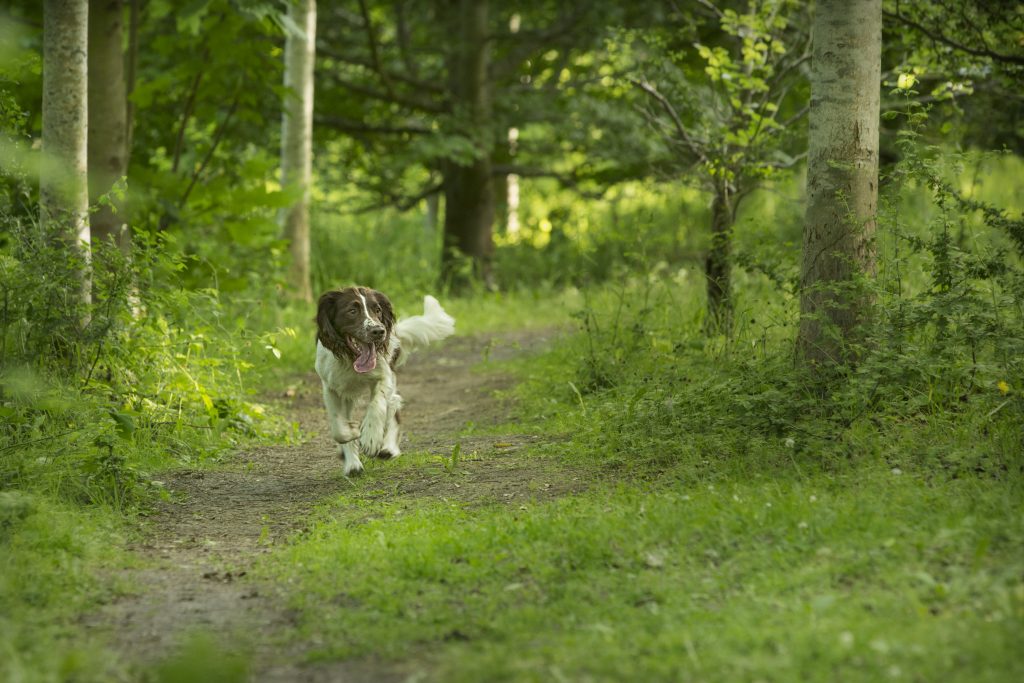
Identification*
Dogs need to have two forms of identification when in a public place – microchipping and a collar with a tag.
Microchipping
All dogs must be microchipped, and the owner’s details must be registered on one of the authorised databases.
Puppies must be microchipped before they go to their new homes, with the breeder being the first registered keeper. They are breaking the law if they do not register the puppy by the time they are eight weeks old. Breeders should also pass on correct microchip paperwork to the new owner when the puppy goes home. You then need to get the information updated to you as the owner.
The law applies to dogs and puppies over the age of eight weeks. Exemptions are available if a vet believes there is a valid health reason not to microchip a dog. The vet must issue the owner with a certificate of exemption in this instance.
Owners are required to keep their pets’ details up to date, for example if they move house. If you rehome your dog to someone else, you must give the new owner the correct microchip registration paperwork so that they can contact the database and register as the dog’s new owner.
What can happen if I break this law?
Owners and breeders who do not get their dog microchipped and registered with an approved database face a fine of up to £500 and could face criminal prosecution. This is also the case if your contact details change and you don’t update your details.
Law: Microchipping of Dogs (England) Regulations 2015, Microchipping of Dogs (Wales) Regulations 2015
Collar and tag
All pet dogs must wear a collar with the owner’s name and address on it when in a public place. The owner’s details can be inscribed on the collar itself or on a tag attached to the collar.
Even if your dog is microchipped, they still need to wear a collar or tag. Exemptions apply for some working dogs.
It’s up to you whether or not you put your telephone number on the collar or tag as well, but we recommend you add your mobile number so you can be contacted at any time in case your dog goes missing.
What can happen if I break this law?
Owners can be fined up to £2,000.
Law: Control of Dogs Order 1992
*the following information was copied from Dogs laws Blue Cross https://www.bluecross.org.uk/advice/dog/dog-laws-uk
Advise given if your dog goes missing.
If your dog goes missing on a walk try not to go too far from where he was last seen as dogs often return to the same place.
If possible also leave some food where he was last seen and an item of your clothing if you can.
If you drove to where he was lost, if safe to do so, you could leave your vehicle engine running and a door open as dogs can recognise the sound of your vehicle.
At home leave a gate open so he can get back in and used bedding/unwashed laundry or an item of your clothing out. Also thoroughly check your house and garden, under hedges, in sheds, garages, outbuildings in case s/he has got stuck or shut in.
Dogs frequently stay very quiet if they are stuck or shut in, so it’s really important to check everywhere thoroughly. Also try to check any CCTV/Ring Doorbell footage for sightings.
Contact the dog warden and local vets, and kennels. Notify your chip company that he is missing. Please make sure chip is registered with the chip company to you and all details up to date.
Please make sure you put the area he went missing and have a contact number at the top of your post. Please register on www.doglost.co.uk, it’s a free service. Once registered local volunteers will be alerted and you’ll be able to print posters to put to up. Postering is very important as not everyone uses social media. Please also be aware of scam callers. Also, contact https://www.facebook.com/groups/DroneSARForLostDogsUK/
Everyone pulls together at times like these. So get the word out there as soon as you can. Call on local friends and family to help you search or sit in your car while you are searching in case they come back.
Firework Night is coming are you prepared?
Is this your dog on Firework night?
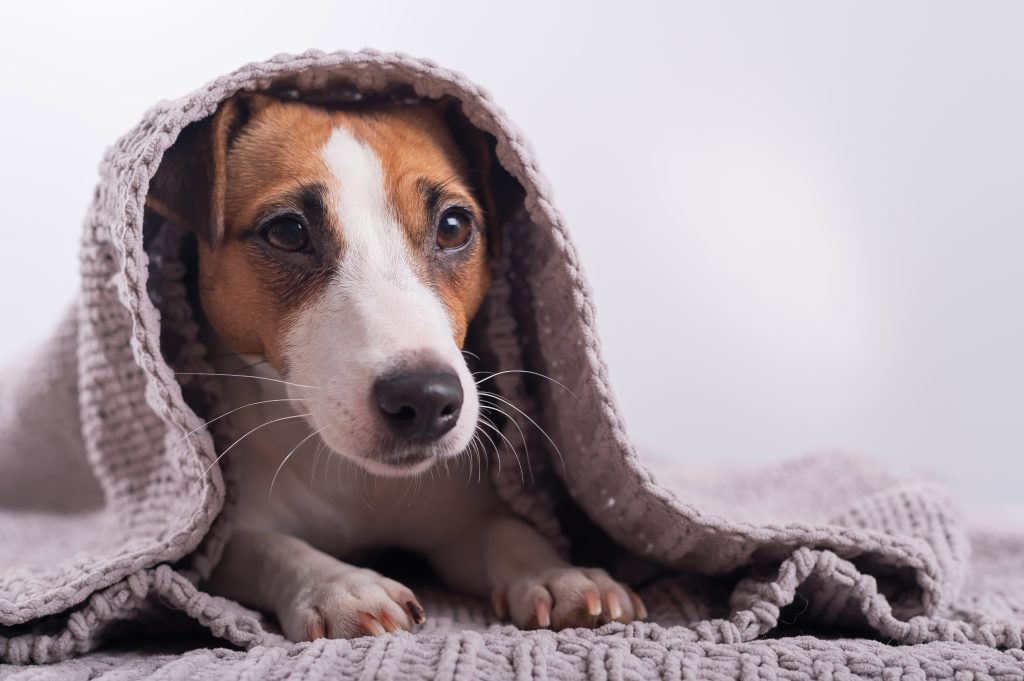
Firework night is just around the corner and if you have not already started, then desensitising your dog to firework sounds is a must for all owners of dogs that are nervous of loud noises or for people with new rescue dogs and have no idea if they will be scared and for new puppy owners.
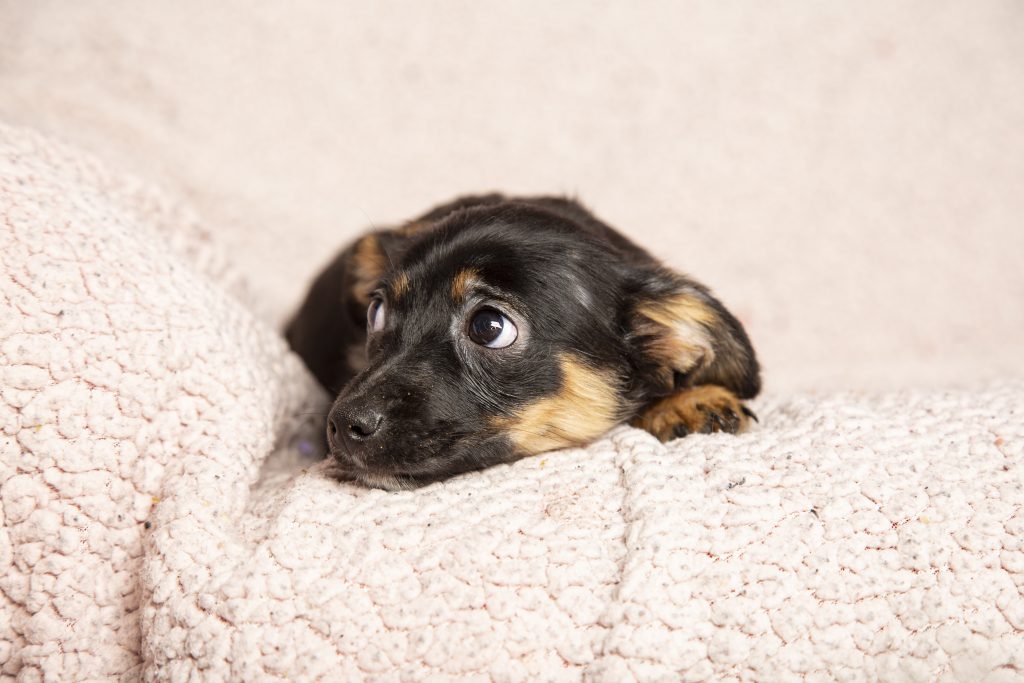
There are all sorts of Fireworks sounds available for you to use on your phone or computer. Start playing them on a very very low volume (remember your dog’s ears are way more sensitive than ours) you want it so low that they either ignore it or only do a momentary glance in the direction of the noise and then continue with what they are doing. Either play or do some simple training activities with your dog or just give them some tasty treats for being around you and ignoring the sounds. The aim is to create a positive emotional response to the sound of fireworks rather than a negative one. You want it to be none of their business, no different to when TV or radio is on.
Firework sounds – https://www.youtube.com/watch?v=eiUT7WKABmw
Gradually increase the sound, do this in different rooms, do it at different times of day and do it in a well-lit room to start with and also in a darker room so your dog is happy in all areas of the house.
Every dog will be different. When your dog is not showing any response to the sound and is happily engaging with you then gradually increase the sound. The slower you do this the better. Again rewarding the dog for not paying attention to the noise. Rewarding regularly especially as the sounds change, from whizz to bangs. Do not increase the volume further until your pet is happy with the volume you are working with.

Other tips for Fireworks Night
Have a den that your dog can go in if they want to. A covered area where they get lots of good stuff, filled kongs, chews, licki mats.. get them loving it during the desensitization with the firework sounds. Again always started on the very very low volume.
Walk your dogs way before Dark on the days coming up to and after firework night.
Close the curtains and blinds
Have the Tv and radio up a little louder to help block out the sounds and windows shut.
Stay in with your dog, if you can’t then see if you have someone that could stay with them.
Have lots of tasty treats and chews etc to keep your dog occupied and rewarded for calmness.
Be safe, be happy!
Dog Accessory Recommendations
I usually get asked for recommendations for various dog equipment and the main three items I usually recommend are harness, long lines and treat pouches so I decided that it would maybe benefit other people to see what those are.
Harness
For my dogs, I love the Perfect Fit Harness and these are the ones I recommend. They are also recommended by many other dog trainers.
Why do I like them?
They fit the dogs really well and do not restrict their shoulders.
They come in three parts (Back, Chest and Tummy) so you can get a really good fit rather than a one size fits all.
They are soft and comfortable for the dogs.
They are machine washable and dry easily.
If a buckle wears then you need only replace the part that is worn, not the whole harness.
They are very durable.

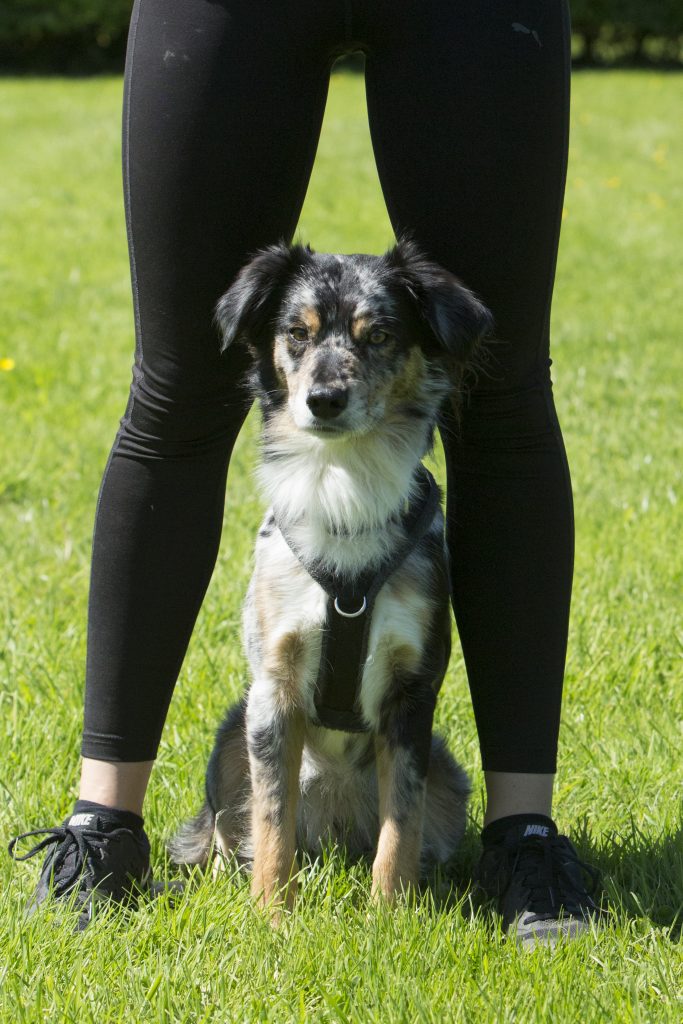
Long Line
For long lines I like the Toozey Range but I also have a Houndability longline which is web and rubber which I quite like and is very similar to the Toozey one.
This is the Toozey Silicone one which is Waterproof so does not get heavy when wet but can be slippery in the hand.
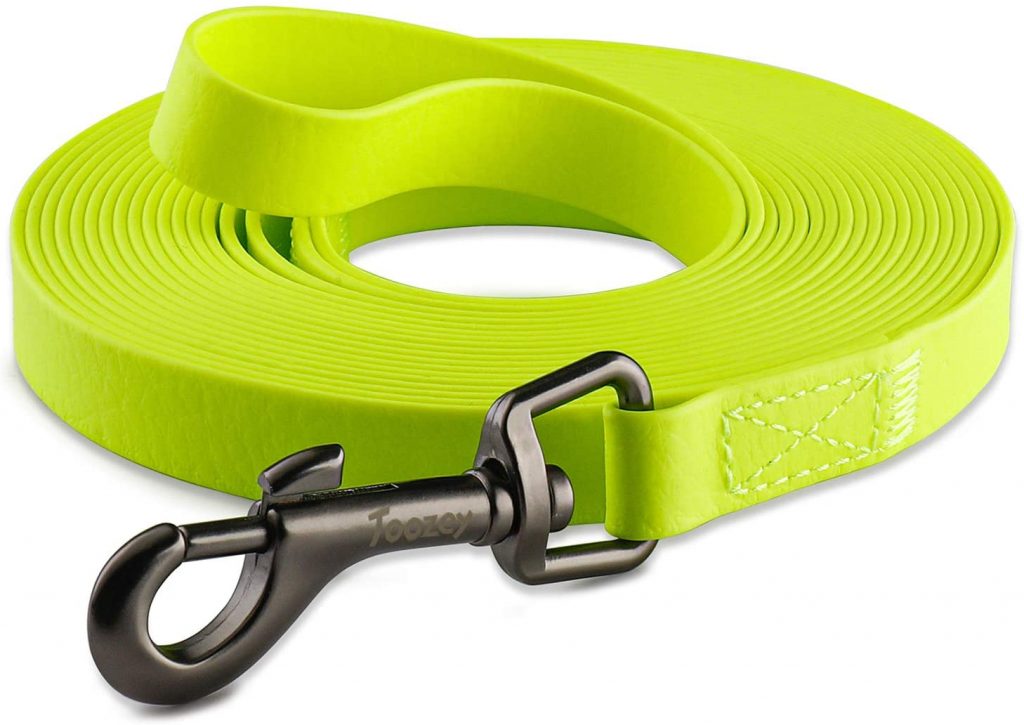
This is the Toozey Web and Rubber one which had a good grip but does get wet and heavier if the ground is wet.
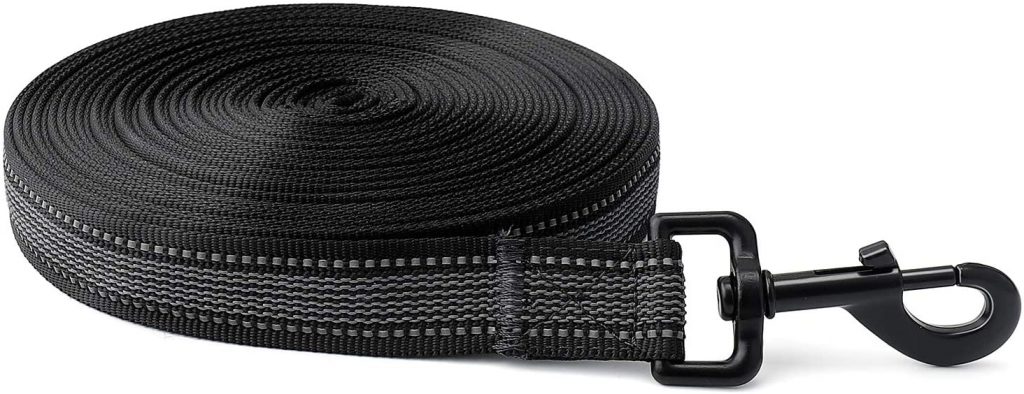
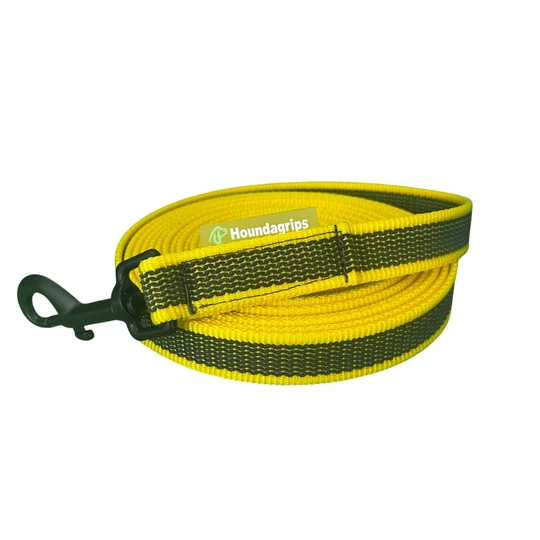
Treat Pouches
I have two different treat pouches that I love.
The first I bought of Ebay but you can also get on Amazon and is a Dexus. Shop around for the best price. This is a smaller pouch.

My larger pouch is The Trainers Pouch and holds about 4 x the amount of the Dexus. Both are fully washable so you can fill them with whatever you want.
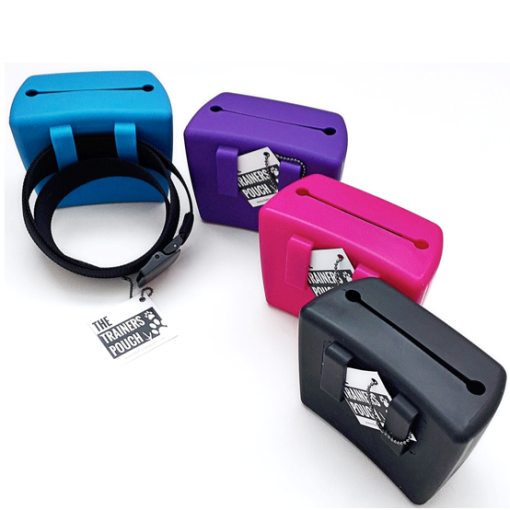
So there you have them, if you get any. I hope you enjoy!
Join the Absolute Dogs – Training Academy
As a Certified Pro Dog Trainer with Absolute Dogs, I am excited to tell you that their Training Academy doors are now open for a limited time. The Netflix of dog training, the games that I teach to get real-life results with your dog available online with additional support Join HERE to get full membership for only £30 a month, that is only £1 a day. Over 200 games to help with your dog training struggles in an easy-to-follow format. Join via my link above and get support via a private group on my Mel Tayor Dog Training Facebook page. Just PM to let me know you have joined using this link Click here. Play the new games along with my dogs, ask for help with existing games, either ask questions or post videos to get feedback. No catches you can cancel at any time.. but you and your dog will be all the better for it. They will be begging you to stay!

Contact me via my website www.meltaylordogtraining.co.uk or at meltaylordogtraining@gmail.com if you would like any further information.
Leaving your dog.
Avoiding your dog getting stressed when you leave.
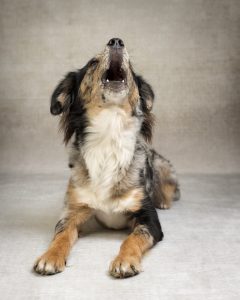
With the Lockdown restrictions coming to an end then leaving your dog at home more is going to be something that is going to start happening. Our dogs have got used to having us around the house most of the time or if you have a new dog or puppy they may have never known any different if you got them during lockdown.
This can cause us to be stressed and worry about whether they will be ok and you may find that it may also stress your dog, if you don’t plan for leaving them in advance you can created yourself a problem. You want to set your dog up to succeed.
Stress when you are absent is most commonly referred to as Separation Anxiety is when your dog starts showing signs of stress when they you are leaving them. There are many different degrees of separation anxiety from mild where the dog may whine for a while to severe where they may cause them self harm. If your dog shows severe signs then you should consult a qualified behaviourist.
Dogs are great at anticipating things, they pick up on predictors all the time. If you pick your car keys up do they get excited? If you put your coat on do they get excited? Then your shoes? …… these are all predictors to your dog that you are going somewhere and their stress levels will start to increase.
So helping your dog when you are leaving is key.
Try not to have a predictable routine every time you are going to leave the house so they are not so able to predict what is going on. Do the things that you do for going out, but actually don’t go out, so pick up the car keys, wander around and put them down. Put on your coat and then take it off again etc.
Try not to make a big thing about leaving, lots of people over fuss their dogs and get them over excited before leaving which leaves them in a high arousal state when you walk out and close that door. Avoid doing this, you don’t need to say goodbye to them and it just becomes another predictor to them.
Keep calm and don’t make a big deal about it.
Leave the dog somewhere where there will be few distractions and it will be calm. Leaving the radio on is also helpful as it also helps mask noise from outside in the environment. Give them something to occupy them a filled kong or a licki matt.

Leaving your dog with the run of the house or a big room can often work against you, as they have more opportunity to pace around and get themselves worked up. If you are leaving them in a crate then you need to think of how long you can do this without the need for the dog to have a break. This will depend on your dog’s breed, age and temperament. IMPORTANT – if leaving them in a crate then make sure you have crate trained them to be happy in a crate otherwise you will introduce a whole set of different issues.
You can ask a neighbour to let you know if the dog is barking or whining excessively when you start back to work.
You may need to organise getting a dog walker in or having family members or friends pop in to let them out for a comfort break. Ensure that they understand about not making a big deal about leaving and arriving too.
If you are leaving your dog in a crate or a room then give them something to occupy them when you go. A filled Kong or a licki mat. Build this up gradually, sometimes go out for a few minutes, sometimes go out and come straight back in, increase the duration, then reduce the time. If you are only using a crate or a room when you are leaving or going to bed, then they can start to associate this area with you leaving so you need to use it at other times throughout the day too, when you are around so the association is not that it is where they go to get left alone.
You need to start this process now, especially if you have concerns that your dog will get stressed and start helping the gradually get used to the idea. If the dog is fussing, then wait for some calm before entering the room. If they remain calm then go in and reward them for the calmness they are showing you.
Think about the mental state of your dog when you are going to leave them. A dog that has been exercised and done a few training activities to tire them out mentally as well a physically are more likely to settle and relax. Don’t leave them immediately after a walk or training, give them some time to chill out a little before you go.
These days it’s easy to monitor how your dog is when you are out these days by getting a camera so you can watch what they are doing. This will give you peace of mind but will also help you identify what is going on if your dog is getting stressed.
When you return to your dog, it needs to be a non event. When our dogs act all excited when we return if we usually reciprocate this with over lavish affections and excitement back to them then it becomes a big deal for them.
Remain calm and when your dog is calm then say hello and praise them in a calm manner.
If you have not been leaving your dog at all and they are always two steps behind you then you need to start some exercises where they get some time without your presence gradually. Scatter some of their daily food allowance in the garden for them to find and when you feel it’s appropriate leave them outside to find the food and come back in, leave the door open so they can come and find you. When you go to the toilet, scatter some food outside and let them clear that up while you do what you need to do without them coming in with you. Invest in a stair gate so they can be in one room and you in another so they get used to the idea that presence doesn’t always mean access to you. Give them a kong or chew to occupy them and help create calmness.

Hopefully, these tips will help you make leaving your dog less stressful for all of you.
Getting a new Puppy?
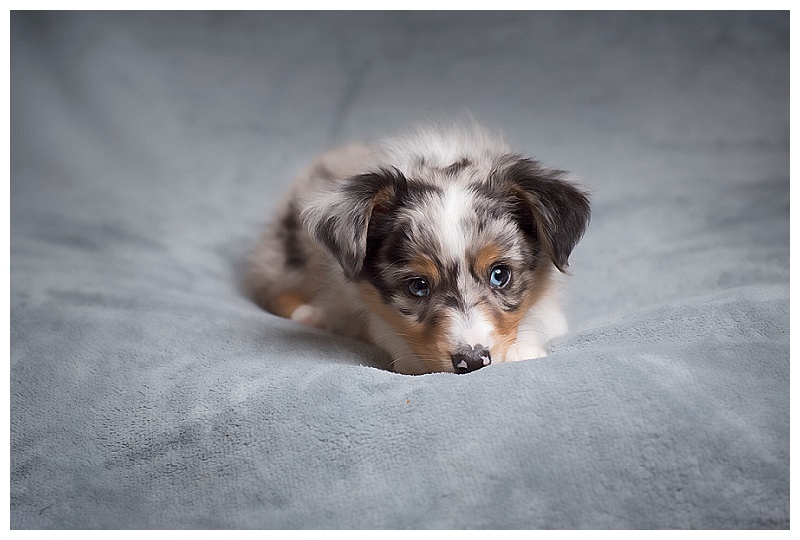
You need to become a Dog Trainer! You owe it to your dog.
So you have decided to add a Puppy to your family!
The first piece of advice you will normally be given is to take it to puppy classes!
Unfortunately not all puppy classes are run well and not all puppies are suited to learning in this environment and you can do your puppy more harm than good.
It has always been the way that you would get your puppy from the breeder at around 8 weeks, get all the vaccinations done and then enrol onto the local puppy class, due to the vaccinations, this is usually not done until they are 12-14 weeks of age if not older and BOOM….. you have missed the crucial learning period before 12 weeks altogether and habits have been formed that are hard to break before you have even got to puppy class!
My advice for any new puppy owner is to take one or two 1-2-1 sessions prior to even picking up your puppy to discuss what your plan is in those crucial first weeks at home will be.
- Do you have everything set up for the first day they will be arriving home.
- How best to settle them.
- You need to know, how you can best deal with toilet training.
- What your ground rules as a family will be, everyone needs to be consistent or the end result can be awful.
- What can you teach your puppy in those first weeks at home before you can get out and about.
- How can you keep them occupied,
- How will you deal with introducing to any other family pets… and to get it right you need to have a plan right from the beginning or without knowing you can teach your dog bad habits without knowing you are doing it.
Our knowledge of dogs is continually growing and there are many more scientific studies. A lot of classes are run by old fashioned trainers who do not keep up with the new ways of thinking are not always well structured and can turn into a free for all play session. This will result in problems especially if you have a highly excitable pup or a nervous pup.
There are three types of dog trainers out there. What one would you prefer to be?
- Trainer 1 – Old School – Domination over the dog
- Trainer 2 – Reward-based behaviour training
- Trainer 3 – New Games based, positive reward, concept building training for real-life results
THE TRAINER 1
These trainers get their results by using intimidation and sometimes force and punishment. They may use choke chains, prong collars, shock collars, noise bottles, sprays, etc. to force the dog to do what they want. They will raise their voice, use harsh tones and words, and try to dominate the dog.
What happens here is the relationship with the dog is damaged, there is no trust and their behaviour more often than not will be worse and the dog is scared of the owner rather than wanting to be with them.
THE TRAINER 2
These trainers are much nicer, they will use food, and toys for rewarding the dog. They teach dogs behaviours and reward for the result but they are constantly telling the dogs what to do and manage situations all the time rather than encouraging the dog to do things because they want to. It this scenario, in the home the garden, the class the dog does everything they want but as soon as they go for a walk, the dog does not listen. The dog is easily distracted by the environment (dogs, cats, people, squirrels) and can’t disengage from then.
But, the thing about Trainer 2s is that they focus on behaviours. They are constantly telling the dog what to do. They rely on the management of the situation. The dog is not taught to think for themselves.
THE TRAINER
These trainers are Game Changes they are inspired by games based training. Playing games with your dog that teach concepts rather than just behaviours. The dogs are taught concepts (tools) that they need to be able to deal with real-life situations such as impulse control, focus, optimism, arousal management, and calmness is key! They work with the dog to make good choices, the choices you want them to make, to find you more fun than the environment, they want to be with you, more than the dog across the park, or the squirrel running across the top of a fence.
This can all be done via games, there are lots of them. Developed and taught by Absolute dogs in Devon, founded by Lauren Langman a top agility trainer in the UK and Tom Mitchell a Veterinary Behaviourist. The games are taught by Certified Pro Dog Trainers to spread this new way of thinking and teaching our dogs.
The most important thing to remember is that you are your puppy’s guardian. You should aim to get the best training possible and never allow anyone to get you to do something with your dog that you are not comfortable with.
Think about those Paws in this heat!
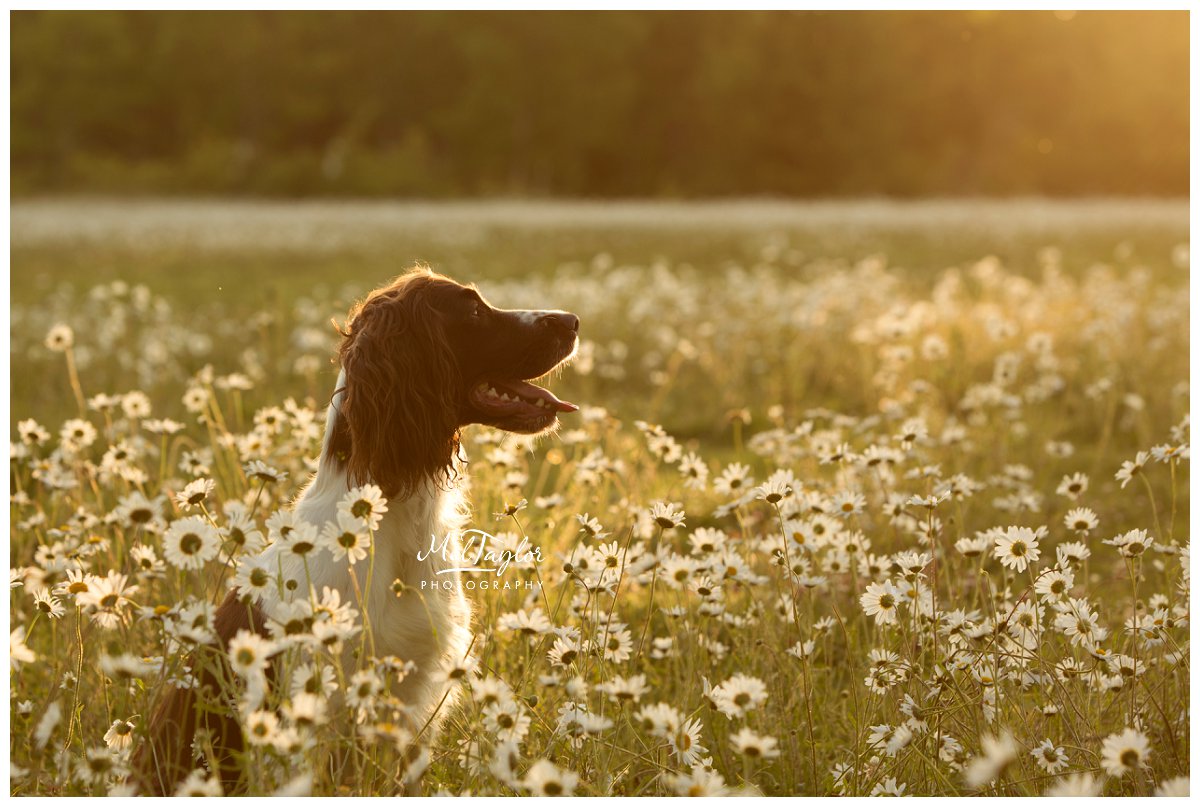 How hot is too hot to walk a dog on a pavement
How hot is too hot to walk a dog on a pavement
Dogs can suffer burns to their paws on days most people wouldn’t consider searingly hot.
If the outside temperature is a pleasant 25C (77F), there’s little wind and humidity is low, asphalt and tarmac can reach a staggering 52C (125F).
This can rise to 62C (143F) when the mercury hits 31C (87F).
It’s worth bearing in mind that an egg can fry in five minutes at 55C (131F) while skin destruction can occur in just one minute at 52C (125F).
The reason pavements get so hot is they soak up heat all day and then retain that heat.
Are all surfaces potentially dangerous for dogs on hot days?
Studies have shown that some surfaces retain heat far better than others.
In one university experiment, the temperature of six different surfaces was taken at two points in the day on two separate summer’s days.
The results showed that artificial grass came out hottest in all four trials, followed by the material that’s used to make running tracks and then asphalt.
Asphalt is the most widely used material in roads and pavements throughout the UK while artificial grass is increasingly being used to replace natural grass in parks and gardens.
All three surfaces measured upwards of 50C (122F) at 2pm on both days. This temperature could severely burn a dog’s paws within a matter of minutes.
Brick and concrete came next in the surface temperature league table followed by natural grass. While sand wasn’t included in this experiment, it can get exceedingly hot too.
The fact natural grass was the coolest of the six suggests that owners should choose it to walk their dogs on hot summer’s days (although our strong advice is to exercise dogs before 8am and after 8pm when temperatures are no longer as high).
Protect your Dog
- Follow the seven-second rule and check the surface for heat before you leave the house.
- Place the back of their hand on the surface for seven seconds. If you struggle to hold it down then it’s too hot to walk the dog,
- Keep to natural grass
- Walk early in the morning or late in the evening when surfaces are cooler
(Ref – Vets Now, Why dog owners should avoid pavements and fake grass on hot days. June 2018)


